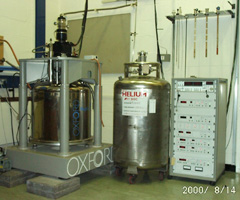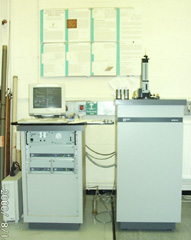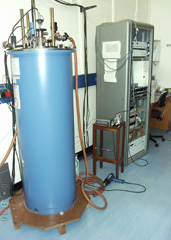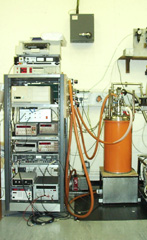
Laboratory Measurements
|
[c]
Our laboratories here at Warwick are well equipped for the study of superconducting and magnetic materials. Magnetic MeasurementsWe have established a Centre for Magnetic Measurements based in the laboratories of the Superconductivity and Magnetism Group here in Physics Department at the University of Warwick. The magnetometers and susceptometers described below are used to make measurements on a wide range of magnetic materials. Research scientists from many different disciplines including Physics, Biology, Chemistry and Materials Science have already taken advantage of these facilities. Some of the users are from Departments here at Warwick, while others are based at other UK HEI's or research centres. If you think that studies of the magnetic properties of your samples may be of help in your work, please contact us to discuss the possibility of collaborating.
Oxford Instruments Vibrating Sample Magnetometer
Quantum Design MPMS-5S SQUID Magnetometer
AC SusceptibilityWe have built an ac magnetic susceptometer to perform low field ac susceptibility measurements at temperatures between 1.5-320K in the frequency range 20 Hz to 10000Hz and where Hac < 100 Oe. Thermodynamic MeasurementsQuantum Design Physical Properties Measurement System (PPMS)
For more infomation on the PPMS heat capacity system click here to view a PDF file of the Quantum Design Application Note Transport MeasurementsWe have a number of cryostats suitable for carrying out transport measurements. Oxford Instruments 9T Cryomagnet
Linde Kryotechnic TCF10 Helium Liqufier
The Physics Department has its own Linde TCF10 helium liquefier. This system is manged by the Superconductivity and Magnetism Group and provides liquid helium to all the research groups in the Department who use low temperature equipment. The TCF10 is a fully automatic computer controlled helium liquefier using turboexpanders and a screw commpressor (Kaeser CSD82). The system includes an oil removal skid, built in drier and low loss purifier, and a pure gas buffer. In normal operation, the cold box can produce 11 litres of liquid per hour that is stored in a 1000 litre vessel for distribution in mobile dewars to our research laboratories. Recovery systems on each cryostat collect the helium gas which is stored in a 10m3 balloon before being compressed into bundles of high pressure (300 bar) storage bottles by a recovery compressor (Bauer Verticus 5).
|









